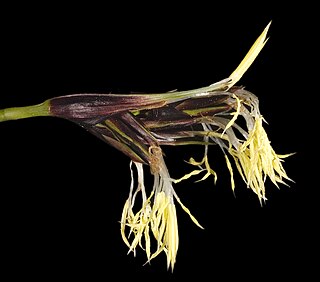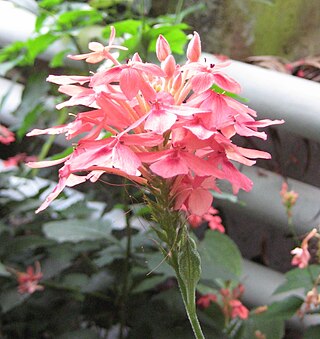
The Cyperaceae are a family of graminoid (grass-like), monocotyledonous flowering plants known as sedges. The family is large, with some 5,500 known species described in about 90 genera, the largest being the "true sedges" genus Carex with over 2,000 species.

Christian Gottfried Daniel Nees von Esenbeck was a prolific German botanist, physician, zoologist, and natural philosopher. He was a contemporary of Goethe and was born within the lifetime of Linnaeus. He described approximately 7,000 plant species. His last official act as president of the German Academy of Natural Scientists Leopoldina was to admit Charles Darwin as a member. He was the author of numerous monographs on botany and zoology. His best-known works deal with fungi.

Hermann Wilhelm Rudolf Marloth was a German-born South African botanist, pharmacist and analytical chemist, best known for his Flora of South Africa which appeared in six superbly illustrated volumes between 1913 and 1932. This botanist is denoted by the author abbreviation Marloth when citing a botanical name.

Ficinia is a genus of tufted or rhizomatous sedges in the family Cyperaceae. There are around 70 recognised species in Africa, four species that occur in New Zealand and a single species Ficinia nodosa that occurs in Australia.

Schoenus is a predominately austral genus of sedges, commonly known as bogrushes, or veldrushes in South Africa. Species of this genus occur mainly in South Africa, Australia and Southeast Asia. Others are found in scattered locations worldwide, from Europe to Asia, North Africa and the Americas. Three species occur in the peatlands of southern South America, including S. antarcticus which is found in Tierra del Fuego, where it forms a component of hyperhumid Magellanic moorland.

Tetraria is a genus of flowering plants in the sedge family, Cyperaceae, native to Tanzania, South Africa, Borneo, Australia and New Zealand.

Wooleya is a monotypic genus of flowering plants belonging to the family Aizoaceae. It only contains one known species, Wooleya farinosa. It is also in tribe Ruschieae.

Lobostemon is a genus of flowering plants belonging to the family Boraginaceae. It is endemic to the Cape Provinces of South Africa. The majority of species are limited to the winter rainfall area of the country, from Springbok to Mossel Bay. In Afrikaans these species are known as agtdaegeneesbos, or loosely translated, bush that will heal in eight days. As this name suggests, many species have medicinal properties. This is best known from Lobostemon fruticosus, which is used for treating wounds, blood poisoning, ringworm, skin diseases and syphilis.
Hammeria is a genus of flowering plants belonging to the family Aizoaceae.
Jacobsenia is a genus of flowering plants belonging to the family Aizoaceae.

Montinia is a monotypic genus of flowering plants belonging to the family Montiniaceae. It only contains one known species, Montinia caryophyllaceaThunb.
Moquiniella is a monotypic genus of flowering plants belonging to the family Loranthaceae. It only contains one known species, Moquiniella rubra(A.Spreng.) Balle
Mossia is a monotypic genus of flowering plants belonging to the family Aizoaceae. It only contains one known species, Mossia intervallaris.
Ruelliopsis is a monotypic genus of flowering plants belonging to the family Acanthaceae. It only contains one known species, Ruelliopsis setosa(Nees) C.B.Clarke
Reedia is a monotypic genus of flowering plants belonging to the family Cyperaceae. It only contains one known species, Reedia spathaceaF.Muell.
Koyamaea is a monotypic genus of flowering plants belonging to the family Cyperaceae. The only species is Koyamaea neblinensisW.W.Thomas & G.Davidse.
Marlothistella is a genus of flowering plants belonging to the family Aizoaceae. It is native to the Cape Provinces of South Africa.

Morelotia is a genus of flowering plants belonging to the family Cyperaceae. It contains six species of sedges native to New Zealand, the Hawaiian Islands, Tubuai Islands, and Western Australia.
Nelmesia is a monotypic genus of flowering plants belonging to the family Cyperaceae. The only species is Nelmesia melanostachyaVan der Veken.

Ruspolia is a genus of flowering plants belonging to the family Acanthaceae.











